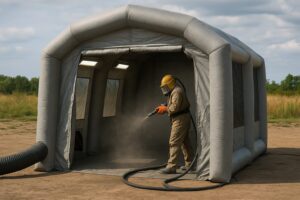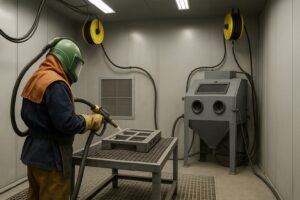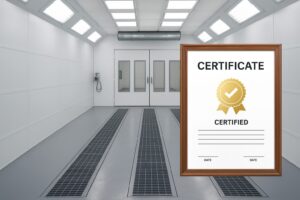If you’ve ever walked by a sandblasting booth while it’s in full operation, chances are you’ve heard it before you saw it. That unmistakable roar, like a hundred angry bees in a tunnel, is hard to miss. But just how loud is it inside one of these booths, and what does that mean for the people who work in or around them every day? Let’s take a closer look at what the noise levels are really like in a sandblasting booth and why it matters more than you might think.
The Roar of Sand and Steel
To understand the noise, first, you have to understand what’s going on inside the booth. Sandblasting or abrasive blasting is the process of propelling small, abrasive materials (like sand, glass beads, or aluminum oxide) at high speeds onto a surface. The goal is to clean it, roughen it, or strip away old coatings like paint or rust.
The equipment involved in this process is powerful. Air compressors, blasting nozzles, and reclaim systems all contribute to the sound environment. When that abrasive material hits the surface, it doesn’t do so quietly. The impact generates a high-decibel echo, especially in an enclosed metal or concrete space. Combine that with the steady airflow and the mechanics of the blast pot and recovery system, and you’ve got a recipe for serious sound.
On average, the noise level inside a sandblasting booth ranges between 100 and 115 decibels (dB). To put that into perspective, normal conversation is around 60 dB. A chainsaw runs at about 110 dB. And a rock concert? Somewhere around 120 dB. That means being inside an active sandblasting booth is about as loud as standing near the speakers at a music festival—but without the catchy tunes.
Why These Noise Levels Matter
You might think, “Well, it’s noisy, but isn’t that just part of the job?” True, many industrial environments are loud, but noise at this level is more than just annoying—it can be dangerous.
According to occupational safety guidelines, exposure to sounds above 85 dB for extended periods can cause permanent hearing damage. At 100 dB, even 15 minutes of unprotected exposure can lead to hearing loss. So, imagine what repeated daily exposure to 110 dB without proper protection can do.
Hearing damage isn’t just about volume. It’s about duration. A worker spending hours in a booth without hearing protection is risking more than a headache—they’re putting their long-term auditory health on the line.
Sound in a Sealed Space
Another reason sandblasting booths are so loud is their construction. Most booths are built with metal panels or hard walls that reflect sound rather than absorb it. So instead of dispersing the noise, it bounces back and forth inside the booth, amplifying the experience for the operator.
Unlike a wide-open workspace, there’s no room for the sound to escape or fade away naturally. It stays trapped inside, creating what’s essentially an echo chamber of blasting noise. Some newer booths incorporate sound-dampening materials or designs that reduce reverberation, but in many traditional setups, the noise levels are still intense.
Hearing Protection Is Not Optional
The good news? Technology and safety gear have come a long way. These days, there are several layers of protection that can make a big difference for those working in or near a sandblasting booth.
Operators typically wear heavy-duty earmuffs or noise-canceling helmets built specifically for industrial environments. Some even include integrated communication systems, allowing the operator to speak with team members outside the booth without needing to take off their gear. These modern solutions not only block out harmful decibels but also make the workspace more functional and safer overall.
Earplugs can offer basic protection, but they’re generally not enough on their own in such a high-decibel environment. A combination of earplugs and earmuffs—known as dual protection is often the best approach when working in booths that exceed 100 dB.
The Impact on the Surrounding Workplace
Of course, the operator isn’t the only one affected. Sandblasting booths can impact the noise level of an entire facility. If your booth isn’t sound-insulated, that relentless blasting noise might spill over into nearby workspaces, causing distractions and even stress for other workers.
That’s why many businesses choose to invest in noise control measures, like installing booths with sound-dampening walls or setting up physical barriers between the booth and other work areas. Some facilities even install entire acoustic enclosures around their sandblasting booths to contain the noise.
Reducing noise pollution in a facility isn’t just good for hearing protection—it’s also good for overall productivity. A quieter environment means fewer distractions, clearer communication, and a more focused team.
Making Noise Levels a Part of Your Planning
If you’re considering installing a sandblasting booth or upgrading an existing one, noise levels should absolutely be part of your planning process. It’s not just a comfort issue—it’s a safety one. Think about where the booth will be placed, what type of walls or soundproofing it includes, and what kind of personal protective equipment (PPE) will be provided to staff.
Choosing quieter blast media, adjusting air pressure settings, or automating certain parts of the process can also help reduce noise output. It’s about creating a balance between performance and protection.
In a Nutshell
Working in or around a sandblasting booth isn’t a silent job and it never will be. The nature of the process demands power, force, and impact, all of which come with sound. But that doesn’t mean noise has to be a hazard.
With smart planning, the right equipment, and proper safety protocols, you can manage noise levels effectively. At the end of the day, protecting hearing is just as important as protecting eyesight, lungs, or skin in an industrial setting. After all, sound may be invisible, but the damage it causes is very real.
Whether you’re designing a new facility or improving your current one, don’t let noise be an afterthought. Because when it comes to sandblasting, what you don’t hear down the line could be the result of what you didn’t protect against today.
Specialized Sandblasting Booth Services
We specialize in providing top-quality sandblasting booths and custom finishing solutions tailored to meet the unique needs of various industries. Our expert team designs and manufactures state-of-the-art sandblasting booths that ensure safety, efficiency, and superior performance. From automotive and aerospace to marine and industrial applications, our booths are engineered to handle even the most demanding surface preparation tasks. We offer comprehensive services, including booth installation, maintenance, upgrades, and technical support.




